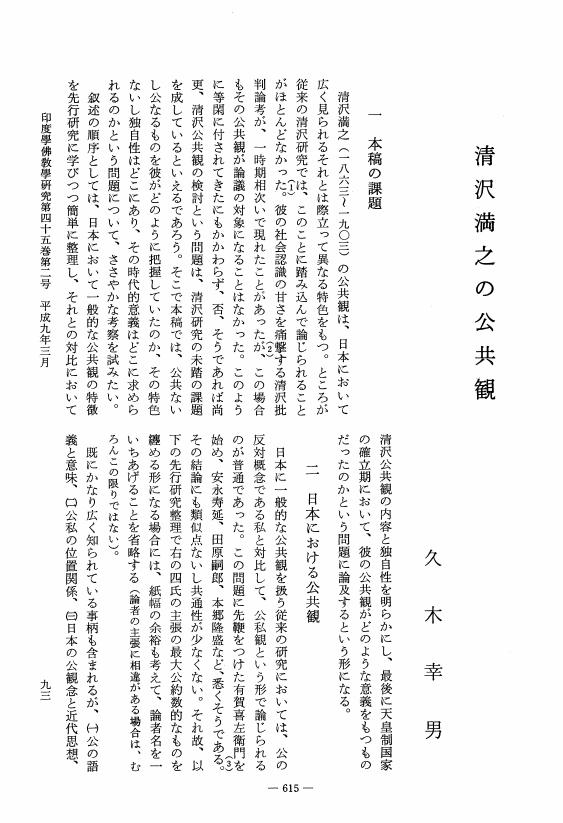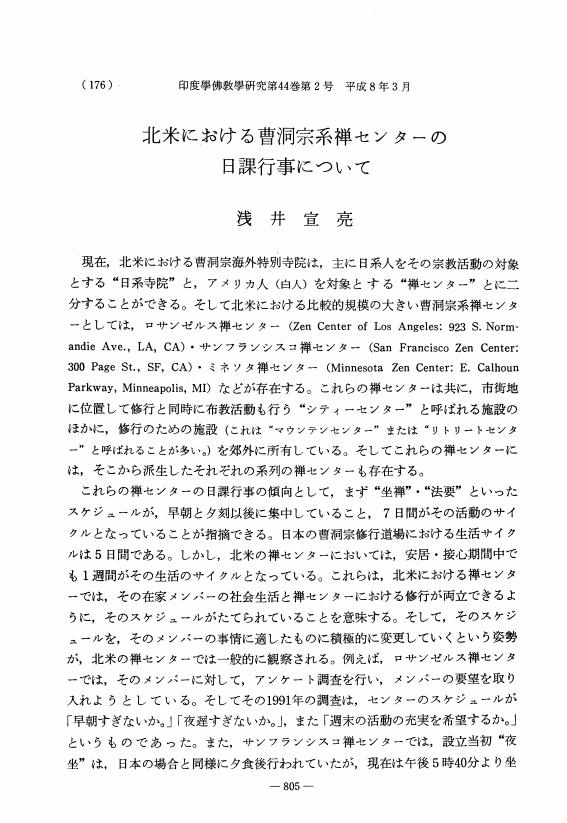1 0 0 0 OA 馬祖禪の諸問題
- 著者
- 柳田 聖山
- 出版者
- Japanese Association of Indian and Buddhist Studies
- 雑誌
- 印度學佛教學研究 (ISSN:00194344)
- 巻号頁・発行日
- vol.17, no.1, pp.33-41, 1968-12-25 (Released:2010-03-09)
1 0 0 0 OA 曹洞宗教団史における参同契・宝鏡三昧
- 著者
- 佐藤 俊晃
- 出版者
- Japanese Association of Indian and Buddhist Studies
- 雑誌
- 印度學佛教學研究 (ISSN:00194344)
- 巻号頁・発行日
- vol.39, no.2, pp.732-735, 1991-03-20 (Released:2010-03-09)
1 0 0 0 OA 懲罰羯磨と僧残罪
- 著者
- 青野 道彦
- 出版者
- Japanese Association of Indian and Buddhist Studies
- 雑誌
- 印度學佛教學研究 (ISSN:00194344)
- 巻号頁・発行日
- vol.57, no.3, pp.1211-1214, 2009-03-25 (Released:2017-09-01)
パーリ律「羯磨犍度」に説かれる七種の懲罰羯磨の適用範囲について論じる際,従来,<懲罰羯磨を「不応悔罪」に科した場合,その羯磨は違法なものとなる>という記述,及び,それに対するSamantapasadika(=Sp)の<「不応悔罪」とは,波羅夷罪及び僧残罪である>という註釈が注目されてきた.そして,懲罰羯磨は波羅夷罪と僧残罪以外の「応悔罪」について科すべきものと理解されてきた.ところで,パーリ律には,これと矛盾する<習慣的行為に関して過失がある比丘に,サンガは望むならば,懲罰羯磨を科すべきである>という記述がある.従来の研究では,Spの当該箇所にはその註釈が存在しないためか,この記述の内実について注目されなかった.しかし,apubbapadavannanaというSpの註釈方針を念頭に入れると,先行する箇所に<「習慣的行為に関して過失がある」とは,波羅夷罪と僧残罪を犯したことである>という註釈が見出せる.即ち,懲罰羯磨は波羅夷罪及び僧残罪にも科しうると言うのである.この矛盾について,復註Saratthadipanitikaが言及し,その解決法を提示している.復註は,<懲罰羯磨は僧残罪に科すことができる>という前提に立ち,矛盾する記述を整合的に説明しようと試みる.この説明を鵜呑みにはできないが,復註の<懲罰羯磨は僧残罪に科すことができる>という見方を支持する記述がパーリ律の依止羯磨の因縁譚に見出せるため,安易にその見方を排除すべきではない.懲罰羯磨の適用範囲について検討する際,従来,波羅夷罪及び僧残罪は排除されてきた.しかし,パーリ律内部の矛盾を直視するならば,我々は従来の見方に止まることはできず,懲罰羯磨が僧残罪に科される可能性も考慮する必要があろう.
1 0 0 0 OA 毘沙門天霊験譚の成立について -不空と毘沙門天の関係を中心に-
- 著者
- 小師 順子
- 出版者
- Japanese Association of Indian and Buddhist Studies
- 雑誌
- 印度學佛教學研究 (ISSN:00194344)
- 巻号頁・発行日
- vol.53, no.1, pp.208-210, 2004-12-20 (Released:2010-03-09)
1 0 0 0 OA 不空訳『毘沙門儀軌』について
- 著者
- 石井 正稔
- 出版者
- 日本印度学仏教学会
- 雑誌
- 印度學佛教學研究 (ISSN:00194344)
- 巻号頁・発行日
- vol.68, no.1, pp.190-193, 2019-12-20 (Released:2020-09-10)
- 参考文献数
- 6
- 被引用文献数
- 1
This paper focuses on bibliographical information concerning the Pishamen yigui 毘沙門儀軌 translated by Amoghavajra 不空. Previous studies have considered that this work is of non-Indic origin. The Pishamen yigui consists of three parts: Yiguibu 儀軌部, Yuanqibu 縁起部, and Siji 私記. Since the contents of these three parts are not connected to each other, they seem to have developed separately. Moreover, this text is not contained in the catalogue (表制集) of texts translated by Amoghavajra. Therefore, the translator (or compiler) of this Yigui should not be accepted as Amoghavajra.The text of this Yigui contained in the presently used canons is derived from a version preserved in the Hasedera in Japan. This is most likely derived from a text found in the Kozanji edited by Jijun 慈順.
1 0 0 0 OA 清沢満之の公共観
- 著者
- 久木 幸男
- 出版者
- Japanese Association of Indian and Buddhist Studies
- 雑誌
- 印度學佛教學研究 (ISSN:00194344)
- 巻号頁・発行日
- vol.45, no.2, pp.615-620, 1997-03-20 (Released:2010-03-09)
1 0 0 0 OA 羅什訳『妙法蓮華経』の問題点 (4)
- 著者
- 苅谷 定彦
- 出版者
- Japanese Association of Indian and Buddhist Studies
- 雑誌
- 印度學佛教學研究 (ISSN:00194344)
- 巻号頁・発行日
- vol.36, no.2, pp.801-808, 1988-03-25 (Released:2010-03-09)
1 0 0 0 OA 道元とベーメの「自己」について
- 著者
- 笠井 貞
- 出版者
- Japanese Association of Indian and Buddhist Studies
- 雑誌
- 印度學佛教學研究 (ISSN:00194344)
- 巻号頁・発行日
- vol.19, no.2, pp.713-716, 1971-03-31 (Released:2010-03-09)
1 0 0 0 OA 『カーランダ・ヴューハ・スートラ』における六字真言と如意宝珠――象徴性と功徳――
- 著者
- 佐久間 留理子
- 出版者
- 日本印度学仏教学会
- 雑誌
- 印度學佛教學研究 (ISSN:00194344)
- 巻号頁・発行日
- vol.69, no.2, pp.818-811, 2021-03-25 (Released:2021-09-06)
- 参考文献数
- 20
This paper focuses on the symbolism and merits of the six-syllable formula (ṣaḍakṣarī-vidyā), wish-fulfilling jewels (cintāmaṇi), and other symbols that represent the Bodhisattva Avalokiteśvara in the Kāraṇḍavyūha-sūtra (KV). The paper also indicates differences between the Gilgit manuscript version (G ver.) from the 7th century and the Nepal manuscript version (N ver.) dating to after the 11th century.According to the G ver., Avalokiteśvara has symbolic elements such as the six-syllable formula, wish-fulfilling jewels, a hand gesture for the sign of a lotus (padmāṅkā-mudrā), a maṇḍala in which Avalokiteśvara, Amitābha, and Śākyamuni are depicted, and, additionally, a universal emperor (Cakravarti-rāja) and a lotus that are not integrated into the maṇḍala. Conversely, these symbolic elements are integrated into the maṇḍala of the great six-syllable formula described in the N ver.Only the N ver. states that those who propagate the KV with a wish-fulfilling jewel, for example, will be welcomed by twelve Tathāgatas in their last moments. This statement is influenced by the larger Sukhāvatīvyūha-sūtra, which mentions twelve Tathāgatas in the most popular Chinese translation, or nineteen in the Sanskrit version. These Tathāgatas represent a light of the Tathāgata Amitābha, who welcomes a person in his last moments, and the influence of devotion to the paradise of Amitābha is stronger in the N ver. than in the G ver.Consequently, we may conclude that symbolic elements and merits of the six-syllable formula and wish-fulfilling jewels, along with other symbols, have been gradually improved from the G ver. and/or integrated into the N ver. under the influence of Esoteric Buddhism and the cult of Amitābha’s paradise.
1 0 0 0 OA 伊勢神宮御正体厨子
- 著者
- 中原 祥徳
- 出版者
- Japanese Association of Indian and Buddhist Studies
- 雑誌
- 印度學佛教學研究 (ISSN:00194344)
- 巻号頁・発行日
- vol.46, no.2, pp.805-807, 1998-03-20 (Released:2010-03-09)
1 0 0 0 OA 本覚思想と本門思想
- 著者
- 田村 芳朗
- 出版者
- Japanese Association of Indian and Buddhist Studies
- 雑誌
- 印度學佛教學研究 (ISSN:00194344)
- 巻号頁・発行日
- vol.26, no.2, pp.521-529, 1978-03-20 (Released:2010-03-09)
1 0 0 0 OA 金剛乗の比丘アティシャと秘密・般若智灌頂禁止の問題
- 著者
- 静 春樹
- 出版者
- 日本印度学仏教学会
- 雑誌
- 印度學佛教學研究 (ISSN:00194344)
- 巻号頁・発行日
- vol.61, no.1, pp.412-407, 2012-12-20 (Released:2017-09-01)
1 0 0 0 OA 東寺の立体曼荼羅の構想
- 著者
- 真鍋 俊照
- 出版者
- 日本印度学仏教学会
- 雑誌
- 印度學佛教學研究 (ISSN:00194344)
- 巻号頁・発行日
- vol.63, no.1, pp.258-266, 2014-12-20 (Released:2017-09-01)
1 0 0 0 OA 白山修験と庶民信仰
- 著者
- 沼 賢亮
- 出版者
- Japanese Association of Indian and Buddhist Studies
- 雑誌
- 印度學佛教學研究 (ISSN:00194344)
- 巻号頁・発行日
- vol.18, no.2, pp.623-624, 1970-03-31 (Released:2010-03-09)
1 0 0 0 OA Bija Theory in Viniscayasamgrahani
- 著者
- Nobuyoshi Yamabe
- 出版者
- Japanese Association of Indian and Buddhist Studies
- 雑誌
- 印度學佛教學研究 (ISSN:00194344)
- 巻号頁・発行日
- vol.38, no.2, pp.931-929, 1990-03-20 (Released:2010-03-09)
- 被引用文献数
- 1 1
- 著者
- Takashi Iwata
- 出版者
- Japanese Association of Indian and Buddhist Studies
- 雑誌
- 印度學佛教學研究 (ISSN:00194344)
- 巻号頁・発行日
- vol.30, no.1, pp.493-486, 1981-12-31 (Released:2010-03-09)
1 0 0 0 OA 北米における曹洞宗系禅センターの日課行事について
- 著者
- 浅井 宣亮
- 出版者
- Japanese Association of Indian and Buddhist Studies
- 雑誌
- 印度學佛教學研究 (ISSN:00194344)
- 巻号頁・発行日
- vol.44, no.2, pp.805-803, 1996-03-20 (Released:2010-03-09)
1 0 0 0 OA 一遍上人の教化理念
- 著者
- 竹内 明
- 出版者
- Japanese Association of Indian and Buddhist Studies
- 雑誌
- 印度學佛教學研究 (ISSN:00194344)
- 巻号頁・発行日
- vol.19, no.1, pp.362-366, 1970-12-25 (Released:2010-03-09)
1 0 0 0 OA 中道思想と縁起説
- 著者
- 仲宗根 充修
- 出版者
- Japanese Association of Indian and Buddhist Studies
- 雑誌
- 印度學佛教學研究 (ISSN:00194344)
- 巻号頁・発行日
- vol.53, no.1, pp.389-387, 2004-12-20 (Released:2010-03-09)
- 参考文献数
- 1
1 0 0 0 OA 日本仏教と菩薩戒
- 著者
- 竹田 暢典
- 出版者
- Japanese Association of Indian and Buddhist Studies
- 雑誌
- 印度學佛教學研究 (ISSN:00194344)
- 巻号頁・発行日
- vol.33, no.1, pp.1-6, 1984-12-25 (Released:2010-03-09)
- 被引用文献数
- 1
















